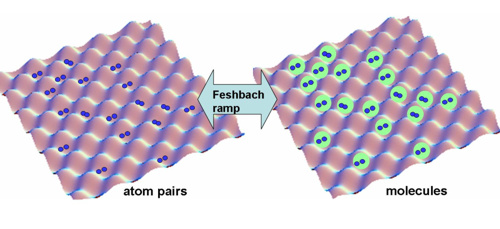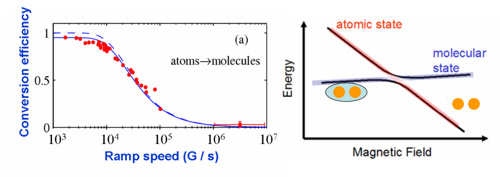Long-live Feshbach molecules in an optical lattice
In the beginning of the experiment we fill an optical lattice with exactly two atoms per lattice site in the vibrational ground state. We can view the lattice sites as nanoscopic test-tubes within which we want to do chemistry.
By ramping over a so called Feshbach resonance we fuse two Rubidium atoms together to form a dimer, Rb2.

We can do this in a very controlled way: With 95% efficiency we can create the molecules in a well defined quantum state. – This is a new record for ultracold molecules consisting of two bosonic atoms. It is also possible to reverse this process: The molecule smoothly disintegrates again into two atoms in the vibrational ground state.
Actually, the efficiency of the atom-molecule conversion depends on the ramp speed, how fast we ramp across the Feshbach resonance. This is due to an avoided crossing of the atomic state and the molecular state. The physics can be effectively expressed by a Landau Zener transition.

Our experiments agree very nicely with theoretical predictions:
Góral et al., J. Phys. B 37, 3457 (2004).
This work is published in:
Long-lived Feshbach molecules in a 3D optical lattice
G. Thalhammer, K. Winkler, F. Lang, S. Schmid, R. Grimm, and J. Hecker Denschlag
Phys. Rev. Lett. 96, 050402 (2006), cond-mat/0510755
